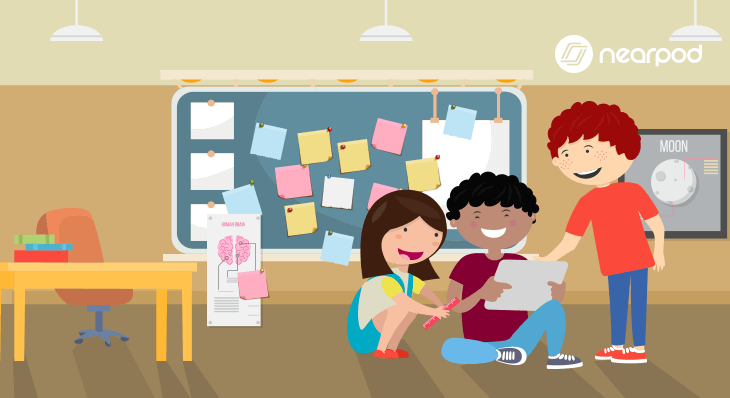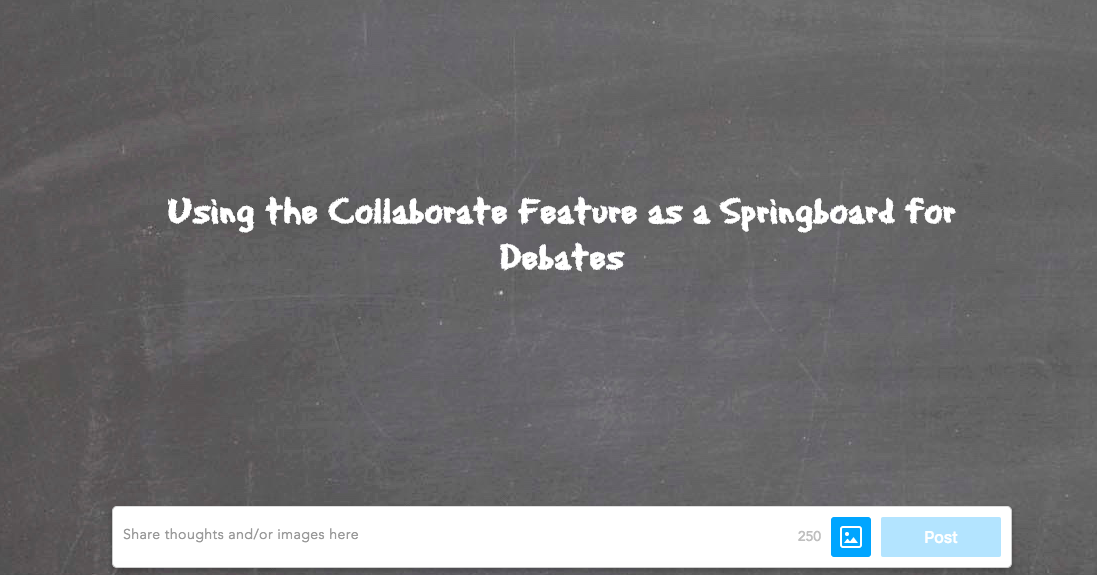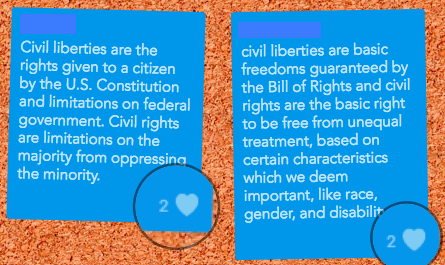
Using Collaborate Boards as a Springboard for Class Debate

If you are reading this, you have most likely been enticed to use Nearpod. Why wouldn’t you? It’s an Ed Tech tool that allows you to compile everything you do as a teacher (engagement activities, web quest, video presentation, formative assessment, etc.) all into one place and allows you to track student data in real time. So long multi-tab teaching! When I first started using Nearpod I thought it was near perfect. As time has passed, I’ve been amazed, again and again, with every new feature and update that the Nearpod team creates.
The Collaborate feature is one of those features that increasingly wows me with every update. It has become one of the features I use the most. I have even found two very unique uses for this feature: incorporating “student voice” into my classroom and using it as a way to initiate a classroom debate.
What is Collaborate?
Before I explain how I used the Collaborate Board to guide a classroom debate, let me take a detour through “student voice.” Yes, “student voice” is another educational buzzword you may have heard floating around in the education space, though, it has become increasingly popular in the past year.
You may be saying to yourself, “What is student voice? Why is it important? And what does it have to do with Nearpod’s Collaborate feature?” All are very valid questions and I’ll be answering them all.
According to eduglossary.org student voice is defined as, “….the values, opinions, beliefs, perspectives, and cultural backgrounds of individual students and groups of students in a school, and to instructional approaches and techniques that are based on student choices, interests, passions, and ambitions.” Science teacher Bill Palmer had this to say about student voice in his article for edutopia.org, “The term ‘Student Voice’ describes how students give their input to what happens within the school and classroom.”
Student voice is allowing students a say in the decision-making process that impacts their education.
Why is it important?
Student voice is important because it allows students the opportunity to be stakeholders in their education. It can increase student engagement in the school community and within the classroom. Student voice also allows students to hone valuable leadership skills they will need as they embark on college and careers. In an ideal world, students would work hand-in-hand with teachers and administrators on leadership teams helping to guide organizational, curricular, and classroom decisions. We don’t live in an ideal world and getting there takes baby steps. The baby step I took was to allow students a voice in choosing their debate topic during the Civil Right and Liberties unit in my AP Government and Politics class.
[click_to_tweet tweet=”What does #StudentVoice have to do with Nearpod’s Collaborate feature?” quote=”What does #StudentVoice have to do with Nearpod’s Collaborate feature?”]
What does Student Voice have to do with Nearpod’s Collaborate Feature?
Before Nearpod, I would choose the debate topic for the students. This would usually focus on a Landmark Supreme Court case that was decided forty or fifty years ago. Once the topic was assigned, I would instruct my students on logistics to complete a Socratic seminar around the assigned case. Students would do the work, but when it came to the day of the debate/seminar it felt as if my students were going through the motions. I decided the debate/seminar was perfect opportunity to bring student voice into my classroom.
Student voice is very much about student choice and Nearpod’s Collaborate feature provides a simple and powerful way for students to have that choice through the use of like/heart button. This is within the Collaborate feature that I have come to love. See the example below.
I decided to use the “liking” feature as a way of giving my students the power to choose their debate topic. Below are the steps I took with my students just in case you would like to recreate something similar in your classroom.
- Split your class into diverse groups of 4 or 5 depending on class size.
- The school district I teach in uses Canvas, so I created a page with links to many major news outlets for them peruse. They had to find an article that chronicled an incident that dealt with free speech, the infringement of it, and legal battle that ensued because of the infringement.
- After each group found an article they felt was suitable, one student from each group posted a link to it on a Nearpod Collaborate board.
- Each group then read the linked articles and used the “like/heart” button to vote for the article with a free speech incident/case they felt was most debatable. They could not vote for their own and the could only vote once.
- Once a topic was chosen, the class was divided based on the different positions presented in their chosen article.
- Over the next two days of class, each debate team completed more research on the incident and developed arguments for a Socratic seminar.
Here is an example of one class’ board with student names removed to respect their privacy.

The process of searching for the articles, posting them, and having students read them, before voting, was time-consuming, but the outcome was well worth it. Students were completely engaged in the discovery and reading process. When it came to voting for the best article on the Collaborate board, they campaigned for theirs and responded with delight as they saw the number of hearts increase. Once each class was done voting, I was rewarded for allowing them to choose.
By using the Collaborate feature in this way, I ended up with debates about whether or not it should be legal to “flip off” police officers, if bakeries should be forced to bake cakes for same sex weddings if the owners are christian and don’t agree with same sex marriage, if lawmakers have the right to ban their constituents from their public candidate Facebook pages, and whether or not students should be forced to get permits and stand in “free speech zones” on college campuses just to handout political pamphlets and other ephemera.
I ended up with richer debates that had taken place in previous years. Students were engaged and impassioned by the topics they had chosen. They were no longer rehashing a historical event they had already learned about half a dozen times. They were reading about and researching real-world applications of the content they had been learning and developing arguments to defend positions. All of this because of allowing a bit of student voice and using Nearpod’s Collaborate feature.

Jamie Parrish is an 18-year veteran teacher from Catonsville, MD. Three years ago he decided to use his Ed Tech skills and knowledge to move towards a paperless classroom. He lives and breaths Ed Tech and is always looking for technology tools that help deliver instruction efficiently, effectively, and most importantly engages students. It is his mission to help students develop the 21st-century skills they will need for college and beyond the classroom.

